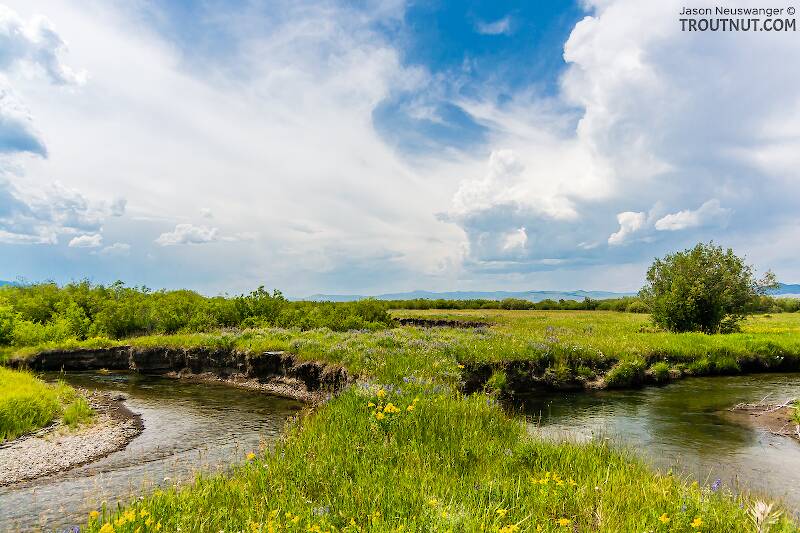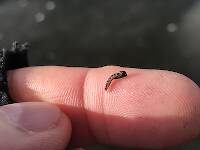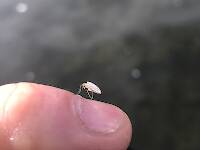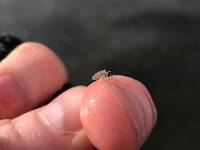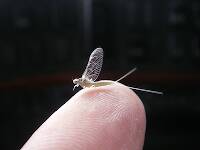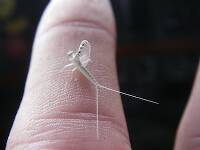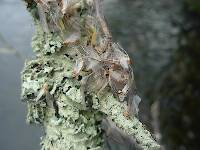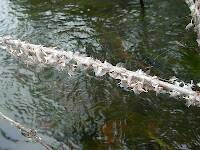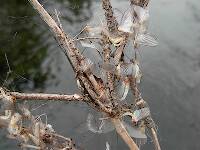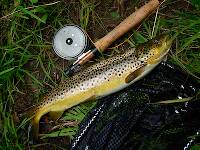
Blue-winged Olives
Baetis
Tiny Baetis mayflies are perhaps the most commonly encountered and imitated by anglers on all American trout streams due to their great abundance, widespread distribution, and trout-friendly emergence habits.
Featured on the forum

It's only barely visible in one of my pictures, but I confirmed under the microscope that this one has a prosternal horn and the antennae are mid-way between the eyes and front of the head capsule.
I'm calling this one Pycnopsyche, but it's a bit perplexing. It seems to key definitively to at least Couplet 8 of the Key to Genera of Limnephilidae Larvae. That narrows it down to three genera, and the case seems wrong for the other two. The case looks right for Pycnopsyche, and it fits one of the key characteristics: "Abdominal sternum II without chloride epithelium and abdominal segment IX with only single seta on each side of dorsal sclerite." However, the characteristic "metanotal sa1 sclerites not fused, although often contiguous" does not seem to fit well. Those sclerites sure look fused to me, although I can make out a thin groove in the touching halves in the anterior half under the microscope. Perhaps this is a regional variation.
The only species of Pycnopsyche documented in Washington state is Pycnopsyche guttifera, and the colors and markings around the head of this specimen seem to match very well a specimen of that species from Massachusetts on Bugguide. So I am placing it in that species for now.
Whatever species this is, I photographed another specimen of seemingly the same species from the same spot a couple months later.
I'm calling this one Pycnopsyche, but it's a bit perplexing. It seems to key definitively to at least Couplet 8 of the Key to Genera of Limnephilidae Larvae. That narrows it down to three genera, and the case seems wrong for the other two. The case looks right for Pycnopsyche, and it fits one of the key characteristics: "Abdominal sternum II without chloride epithelium and abdominal segment IX with only single seta on each side of dorsal sclerite." However, the characteristic "metanotal sa1 sclerites not fused, although often contiguous" does not seem to fit well. Those sclerites sure look fused to me, although I can make out a thin groove in the touching halves in the anterior half under the microscope. Perhaps this is a regional variation.
The only species of Pycnopsyche documented in Washington state is Pycnopsyche guttifera, and the colors and markings around the head of this specimen seem to match very well a specimen of that species from Massachusetts on Bugguide. So I am placing it in that species for now.
Whatever species this is, I photographed another specimen of seemingly the same species from the same spot a couple months later.

Troutnut is a project started in 2003 by salmonid ecologist Jason "Troutnut" Neuswanger to help anglers and
fly tyers unabashedly embrace the entomological side of the sport. Learn more about Troutnut or
support the project for an enhanced experience here.
Shawnny3 on Jun 12, 2012June 12th, 2012, 5:04 am EDT
I was fishing last night when a bunch of different hatches were going on. One of the more prevalent adults I saw flying around looked like tricos in terms of size and body shape but had colors I'd never seen before in a trico. The female spinners were most obvious and were entirely light tan, had bright yellow egg sacs, and two tails. Were these likely tricos, or something else? Sorry, again no pics.
-Shawn
-Shawn
Jewelry-Quality Artistic Salmon Flies, by Shawn Davis
www.davisflydesigns.com
www.davisflydesigns.com
Martinlf on Jun 12, 2012June 12th, 2012, 6:29 am EDT
Shawn, these don't sound like trikes to me. Tricos have three tails. Male tricos hatch at night, the females in the morning. The females have olive abdomens and brownish thoraxes. The spinners swarm in the morning and are typically spent by late morning. Once the eggs are deposited the females' abdomens look whitish. I'll bump up some trico threads that may also help. The spinners you saw may be what I think of as summer olives. The ones I fish over have tan spinners.
"He spread them a yard and a half. 'And every one that got away is this big.'"
--Fred Chappell
--Fred Chappell
Feathers5
Posts: 287
Posts: 287
Feathers5 on Jun 12, 2012June 12th, 2012, 6:39 am EDT
Hey Louis. I think last year we had a discussion about summer olives with Gutcutter and myself. If I remember correctly we even posted several patterns.
Bruce, Goose, Lastchance, Feathers5
Bruce, Goose, Lastchance, Feathers5
Shawnny3 on Jun 12, 2012June 12th, 2012, 8:08 am EDT
That would make more sense - there were quite a few small olive duns around as well. These seemed smaller than most of the olive duns I saw, though - are the summer olives smaller as spinners than they are as duns?
-Shawn
-Shawn
Jewelry-Quality Artistic Salmon Flies, by Shawn Davis
www.davisflydesigns.com
www.davisflydesigns.com
Gutcutter on Jun 12, 2012June 12th, 2012, 8:41 am EDT
Size?
If you were fishing where I think you were fishing, Shawn, there is a small Baetidae (? Genus/species) around a 22-24 that is tan, and hatches in the afternoon.
They usually start towards the end of this month, but this year, all bets are off
If you were fishing where I think you were fishing, Shawn, there is a small Baetidae (? Genus/species) around a 22-24 that is tan, and hatches in the afternoon.
They usually start towards the end of this month, but this year, all bets are off
All men who fish may in turn be divided into two parts: those who fish for trout and those who don't. Trout fishermen are a race apart: they are a dedicated crew- indolent, improvident, and quietly mad.
-Robert Traver, Trout Madness
-Robert Traver, Trout Madness
Entoman on Jun 12, 2012June 12th, 2012, 7:40 pm EDT
Shawn,
You are describing either Procloeon or Centroptilum. Both are closely related genera in the family Baetidae and go by many common names, including Tiny Sulfur Dun and Little Pale Quill. What kind of water were you fishing?
The female spinners were most obvious and were entirely light tan, had bright yellow egg sacs, and two tails.
You are describing either Procloeon or Centroptilum. Both are closely related genera in the family Baetidae and go by many common names, including Tiny Sulfur Dun and Little Pale Quill. What kind of water were you fishing?
"It's not that I find fishing so important, it's just that I find all other endeavors of Man equally unimportant... And not nearly as much fun!" Robert Traver, Anatomy of a Fisherman
Shawnny3 on Jun 13, 2012June 13th, 2012, 7:20 am EDT
A spring creek in the evening (yes, Tony - PM to follow), water temp probably around 60-62 (didn't take a temp that day), fast water, spinners were size 26-28, duns a bit bigger (22-24). There was a bunch of stuff hatching, though (including large dark sulphurs and dark brown caddis ranging from size 22 all the way up to 14), so I'm not sure the BWO duns and spinners were part of the same hatch. Seining without kicking up rocks revealed quite a few dark olive baetis nymphs (or at least what I think are baetis nymphs) in size 22-24 drifting downstream. After seeing all this before wetting a line, I was certain I was in for quite an evening of fishing.
Did I mention I got my butt kicked? I was fishing a newly opened stretch of water that was very fast and surprisingly deep - very difficult fishing. I threw everything I could think of without resorting to streamers, all to no avail. I caught a small brown right at dusk (finally!), only to find he'd been foul hooked - one of those days the fish were conspiring with the bugs to mock me.
-Shawn
Did I mention I got my butt kicked? I was fishing a newly opened stretch of water that was very fast and surprisingly deep - very difficult fishing. I threw everything I could think of without resorting to streamers, all to no avail. I caught a small brown right at dusk (finally!), only to find he'd been foul hooked - one of those days the fish were conspiring with the bugs to mock me.
-Shawn
Jewelry-Quality Artistic Salmon Flies, by Shawn Davis
www.davisflydesigns.com
www.davisflydesigns.com
Gutcutter on Jun 16, 2012June 16th, 2012, 6:40 pm EDT
You are describing either Procloeon or Centroptilum. Both are closely related genera in the family Baetidae and go by many common names, including Tiny Sulfur Dun and Little Pale Quill. What kind of water were you fishing?
I have had terrific fishing to what I presumed and/or was told was this critter in Paradise Valley on several spring creeks. In the fly shops, they always mentioned an afternoon "tiny sulfur dun, you know, centrillium". (sic)
I did great with a #22 TMC 2488 sulfur emerger.
Do we get Centroptilum in central PA?
If so, these may be what hatches after Bruce and I stir up all of the trout in a stream with our trico adventures...
They are a little darker than sulfur, almost a light tan.
Gonzo?
All men who fish may in turn be divided into two parts: those who fish for trout and those who don't. Trout fishermen are a race apart: they are a dedicated crew- indolent, improvident, and quietly mad.
-Robert Traver, Trout Madness
-Robert Traver, Trout Madness
Entoman on Jun 16, 2012June 16th, 2012, 9:08 pm EDT
Tony -
There are at least 9 species of Centroptilum and Procloeon reported for PA. They can be tannish as well as sulfur. Does the hatch you see look pretty close to this? http://www.troutnut.com/specimen/1018
There are at least 9 species of Centroptilum and Procloeon reported for PA. They can be tannish as well as sulfur. Does the hatch you see look pretty close to this? http://www.troutnut.com/specimen/1018
"It's not that I find fishing so important, it's just that I find all other endeavors of Man equally unimportant... And not nearly as much fun!" Robert Traver, Anatomy of a Fisherman
Gutcutter on Jun 19, 2012June 19th, 2012, 11:43 am EDT
Does the hatch you see look pretty close to this?
Kurt
Tough to say. I never saw a spinner, only duns. The color is about right, though. Very well could be the same bug, if they are about a size 24, but that would be a guess on my part.
I'll have to (try and) catch (and photograph) one this year...
I'm usually too busy landing and releasing Bruce's fish
Eric - You frequent these waters, too. any thoughts?
All men who fish may in turn be divided into two parts: those who fish for trout and those who don't. Trout fishermen are a race apart: they are a dedicated crew- indolent, improvident, and quietly mad.
-Robert Traver, Trout Madness
-Robert Traver, Trout Madness
Crepuscular on Jun 20, 2012June 20th, 2012, 4:23 am EDT
I have seen these diminuative flies on a few streams in the north central potion of the state. Cream colored abdomen with a tannish yellow (sulphur) thorax about a size #26 early morning spinner fall. I have not collected any in years so I'd really have to search for them, but if my memory serves they were Centroptilum. But I have had good fishing over them usually around the first week of June. I have run into them on Penns creek as well but usually they are overshadowed by the Cornutas.
Entoman on Jun 20, 2012June 20th, 2012, 9:46 am EDT
Tony -
Those are female duns in the link. The wings are a very pale dun. If the light is right the wings can look fairly clear with these little guys and the spinners are similar colored, so it's an easy mistake to make. The abdomens can also look chalky in the middle after ovipositing their yellow eggs. The male duns are similarly marked but have large orangish eyes. Male spinners usually have more contrast with darker thoraxes and abdomen tips. Their more famous counterparts in Europe (commonly called Spurwings) are larger and more olivaceous.
Nearctic species are mostly reported from waters too warm for trout in the scientific lit and it's undoubtedly true that their most abundant populations can be found there. This has led to an assumption in older angling literature (if they're even mentioned) that they are unimportant. This perception is not accurate. Western anglers are becoming increasingly aware of them and Schwiebert writes fairly extensively in his revised nymphs of their relative importance on several popular PA streams as well as other eastern and midwestern locales.
A good look at the hind wings (or lack thereof) would help though taxonomic realities make it difficult for anglers to rely on this character too much. However, the characters of yellow eggs, two tails, diminutive size, and tannish coloration strongly suggest Centroptillum or Procloeon; most likely the former, due to being more common.
Tough to say. I never saw a spinner, only duns
Those are female duns in the link. The wings are a very pale dun. If the light is right the wings can look fairly clear with these little guys and the spinners are similar colored, so it's an easy mistake to make. The abdomens can also look chalky in the middle after ovipositing their yellow eggs. The male duns are similarly marked but have large orangish eyes. Male spinners usually have more contrast with darker thoraxes and abdomen tips. Their more famous counterparts in Europe (commonly called Spurwings) are larger and more olivaceous.
Nearctic species are mostly reported from waters too warm for trout in the scientific lit and it's undoubtedly true that their most abundant populations can be found there. This has led to an assumption in older angling literature (if they're even mentioned) that they are unimportant. This perception is not accurate. Western anglers are becoming increasingly aware of them and Schwiebert writes fairly extensively in his revised nymphs of their relative importance on several popular PA streams as well as other eastern and midwestern locales.
A good look at the hind wings (or lack thereof) would help though taxonomic realities make it difficult for anglers to rely on this character too much. However, the characters of yellow eggs, two tails, diminutive size, and tannish coloration strongly suggest Centroptillum or Procloeon; most likely the former, due to being more common.
"It's not that I find fishing so important, it's just that I find all other endeavors of Man equally unimportant... And not nearly as much fun!" Robert Traver, Anatomy of a Fisherman
Shawnny3 on Jun 20, 2012June 20th, 2012, 5:57 pm EDT
Very cool responses. Thanks, guys. I will try to post pics next time I find these guys.
-Shawn
-Shawn
Jewelry-Quality Artistic Salmon Flies, by Shawn Davis
www.davisflydesigns.com
www.davisflydesigns.com
Quick Reply
Related Discussions
Topic
Replies
Last Reply
2
Jul 9, 2018
by Martinlf
by Martinlf
11
Aug 29, 2011
by Entoman
by Entoman
10
Jul 27, 2008
by Phillyfired
by Phillyfired
5
Aug 7, 2007
by Wiflyfisher
by Wiflyfisher

